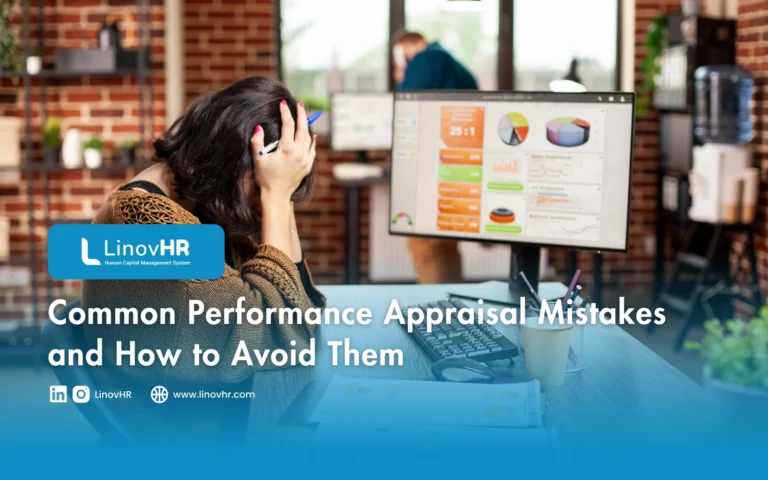Performance appraisals are a cornerstone of effective human resource management. But when done poorly, they can do more harm than good. They provide a structured approach to evaluating employee performance, offering valuable insights into individual contributions, strengths, and areas for improvement.
When done correctly, performance appraisals can motivate employees, align their goals with company objectives, and strengthen overall organizational performance.
However, despite their importance, performance appraisals are often one of the most misunderstood and mismanaged HR processes.
Many companies face challenges such as bias, unclear evaluation criteria, and poor communication, which can reduce the effectiveness of the process.
As a result, instead of driving growth and engagement, appraisals sometimes lead to frustration and disengagement among employees.
This article will explore the most common performance appraisal mistakes organizations make, how to avoid them, and best practices for building a fair, transparent, and effective evaluation system.
What Is Performance Appraisal?
Performance appraisal is a systematic process used by organizations to assess an employee’s job performance over a specific period.
Typically conducted annually or semi-annually, this evaluation allows managers and HR professionals to measure how well employees have met their objectives, contributed to team goals, and demonstrated key competencies.
In modern organizations, performance appraisal plays a crucial role beyond just evaluating work results. It serves as a foundation for talent development, salary adjustments, promotions, and succession planning.
Through structured feedback, employees can understand their performance expectations, recognize their strengths, and identify areas for growth.
Also Read: Performance Appraisal: Definition, Benefits, and Implementation Process
Companies in today’s competitive landscape cannot afford to rely solely on intuition or informal assessments. Performance appraisals provide an objective framework that ensures fairness and consistency across the organization.
They also encourage accountability by aligning individual performance with organizational objectives.
However, despite its value, performance appraisal processes often face criticism due to their execution. Many organizations struggle with issues such as inconsistent standards, manager bias, and ineffective feedback delivery.
These challenges can distort results, damage trust, and ultimately undermine the purpose of performance evaluation. Therefore, understanding the common pitfalls and learning how to address them is essential for every HR professional and business leader.
Top Performance Appraisal Mistakes You Should Avoid
Even though performance appraisals are designed to improve employee performance and organizational growth, many companies still struggle to execute them effectively.
Small mistakes in the process can lead to unfair evaluations, employee dissatisfaction, and poor HR decisions.
Below are ten common mistakes you should avoid in your company’s appraisal system.
1. Lack of Clear Evaluation Criteria
One of the biggest mistakes in performance appraisals is conducting evaluations without clearly defined criteria. When managers rely on vague or inconsistent standards, employees are often left confused about what is expected of them.
This uncertainty makes it difficult to measure progress accurately and may cause frustration when performance ratings feel arbitrary.
Clear performance indicators such as KPIs (Key Performance Indicators) and behavioral standards ensure objectivity and consistency.
When criteria are transparent, employees can focus their efforts on measurable goals, and managers can provide feedback that aligns with company objectives.
2. Infrequent Feedback
Many organizations still treat performance appraisal as a once-a-year event. This outdated approach often results in missed opportunities for growth and improvement.
Employees may only learn about their shortcomings after months of underperformance, leaving little room for real-time correction.
Frequent check-ins and continuous feedback help employees stay aligned with expectations and feel supported in their development journey. Regular communication also fosters trust and makes the annual review more of a summary than a surprise.
Also read: Underperforming Employees: Turning Performance Gaps into Growth Opportunities
3. Bias and Subjectivity
Bias is one of the most damaging issues in performance evaluations. Managers may unconsciously favor employees they personally like or rate recent performance more heavily than consistent year-round results, a phenomenon known as “recency bias”.
To reduce bias, organizations must implement structured evaluation methods, use data-driven insights, and provide training for managers on objective assessment techniques. Fair and transparent appraisals build credibility and employee confidence in the process.
4. Ignoring Employee Self-Assessment
Another common oversight is failing to involve employees in their own evaluation. When only managers provide feedback, the process can feel one-sided and demotivating.
Self-assessments encourage employees to reflect on their performance, achievements, and challenges, creating a more balanced discussion.
Involving employees also increases their sense of accountability and engagement. It transforms performance appraisals from a top-down judgement into a two-way conversation focused on growth and collaboration.
5. Focusing Only on Weaknesses
A performance review that solely highlights what employees did wrong can quickly discourage them. While identifying areas for improvement is essential, focusing exclusively on weaknesses can overshadow achievements and lower morale.
A balanced appraisal should celebrate accomplishments while addressing gaps constructively. Recognizing strengths reinforces positive behavior, motivates employees, and creates a culture of appreciation and continuous improvement.
6. Lack of Training for Managers
Managers play a crucial role in conducting effective performance appraisals. However, many organizations fail to equip them with necessary skills to evaluate objectively and communicate feedback effectively. Poorly trained managers may deliver vague, unhelpful, or overly critical feedback.
Providing training on how to conduct fair evaluations, use HR systems, and hold productive feedback conversations ensures a consistent and effective appraisal process across all departments.
7. Using a One-Size-Fits-All Approach
Every role and employee is unique, yet some organizations apply the same evaluation template to all positions. This approach ignores differences in job responsibilities, performance metrics, and success indicators.
A customized appraisal framework tailored to specific roles provides a more accurate and fair assessment. For instance, measuring creativity and innovation for marketing staff differs greatly from evaluating operational efficiency in finance or HR.
8. Poor Documenting and Record-Keeping
Inconsistent or missing documentation is another frequent problem. Without proper records, it becomes difficult to track employees progress, justify ratings, or support HR decisions such as promotions or disciplinary actions.
Maintaining detailed performance records through digital HR systems helps ensure accuracy and transparency. It also provides valuable data for long-term workforce planning and analytics.
9. Neglecting Goal Alignment
When individual goals are not aligned with company objectives, even high-performing employees may contribute little to organizational success. Many appraisals fail to connect daily tasks and personal goals with the company’s broader vision.
To prevent this, HR and managers should work together to set SMART goals (Specific, Measurable, Achievable, Relevant, Time-bound) that directly support strategic priorities. This alignment ensures every employee effort drives collective growth.
10. No Follow-Up After Appraisal
One of the most critical yet overlooked steps in the appraisal process is post-evaluation follow-up. Many companies stop the process after delivering ratings, missing the opportunity to turn insights into action.
Follow-ups help reinforce accountability and ensure that agreed-upon development plans are implemented. Without this step, performance appraisals lose their strategic value and become a mere formality.
Best Practices to Prevent Performance Appraisal Errors
Recognizing common mistakes is only the first step, preventing them requires strategy, consistency, and the right tools. Organizations that build structures and transparent performance appraisal systems can significantly improve accuracy, fairness, and employee engagement.
Below are five best practices to help HR teams and managers avoid the most frequent appraisal errors.
1. Establish Clear and Measurable Evaluation Criteria
Every appraisal process should start with well-defined performance indicators. These can include quantitative goals like sales targets or project completion rates, as well as qualitative measures such as teamwork and innovation.
By setting clear, measurable expectations early on, both managers and employees understand what success looks like. This clarity minimizes confusion, ensures fairness, and helps employees stay focused on achieving specific outcomes that align with organizational objectives.
Additionally, when employees know the exact metrics used to evaluate them, they are more likely to feel motivated and confident in their performance.
Transparent criteria also help reduce bias, since evaluations are based on data and observable behavior rather than personal judgement.
2. Encourage Continuous Feedback and Regular Check-Ins
Instead of limiting evaluations to annual reviews, HR professionals should promote a continuous feedback culture. Ongoing communications allows managers to address performance issues early, recognize achievements in real time, and guide employees toward improvement throughout the year.
Regular check-ins also strengthen relationships between managers and their teams, creating a more open and supportive work environment. This approach helps employees see performance appraisals not as intimidating events but as opportunities for personal and professional growth.
3. Train Managers on Objective Evaluation and Communication
Managers play a key role in the appraisal process, and their ability to assess fairly and communicate effectively can make or break the system. Providing structured training helps managers identify and minimize unconscious bias, use data-driven insights, and give constructive feedback.
Training sessions should cover techniques for setting SMART goals, conducting balanced discussions, and handling difficult performance conversations with empathy and professionalism.
Well-trained managers not only deliver fairer evaluations but also foster trust and motivation among employees, two crucial factors in driving long-term engagement and retention.
4. Leverage Technology for Appraisal Automation and Data Accuracy
Manual performance appraisals are prone to human errors, delays, and inconsistencies. Modern HR technology offers automated solutions that streamline the process from goal-setting to reporting.
Using a digital system ensures that all evaluations, feedback, and results are recorded accurately in one centralized platform.
Automation also provides valuable analytics for HR leaders, allowing them to identify performance trends, detect potential skill gaps, and design better employee development programs.
By integrating appraisal tools with other HR modules like attendance or training systems, organizations can gain a holistic view of each employee’s contribution making performance reviews more data-driven and reliable.
5. Follow Up and Create Actionable Development Plans
A performance appraisal should never end with scores or ratings. The real value lies in what comes after the evaluation turning insights into actionable development plans.
HR and managers must collaborate with employees to set clear follow-up goals, such as attending training programs, improving specific skills, or preparing for leadership roles.
This proactive approach not only supports employee growth but also reinforces accountability and commitment. When employees see that their feedback leads to tangible actions, they are more likely to stay engaged and motivated to perform better in the future.
Optimize Your Performance Appraisal Process with LinovHR
In today’s fast-paced work environment, relying on manual or outdated performance appraisal methods can lead to inefficiency, bias, and poor decision-making.
LinovHR helps organizations overcome these challenges through a comprehensive, automated, and AI-powered Performance Appraisal system that simplifies every stage of the evaluations process.
With LinovHR, HR professionals and managers can easily set measurable goals, track employee progress in real-time, and conduct fair, data-driven evaluations. The platform also integrated seamlessly with other HR modules, such as attendance, training, and payroll giving a complete overview of employee performance and potential.
LinovHR’s automation ensures consistent appraisal cycles, eliminating administrative errors, and provides analytics to help HR leaders identify top performers and areas for improvement.
Ready to make your performance evaluations smarter and more efficient? Request a free demo today and experience how LinovHR can transform your performance appraisal process!





